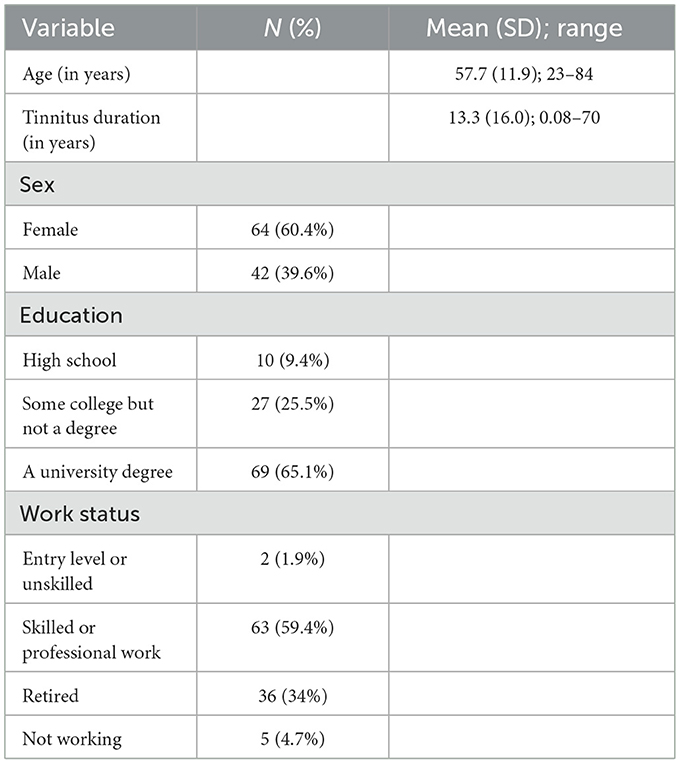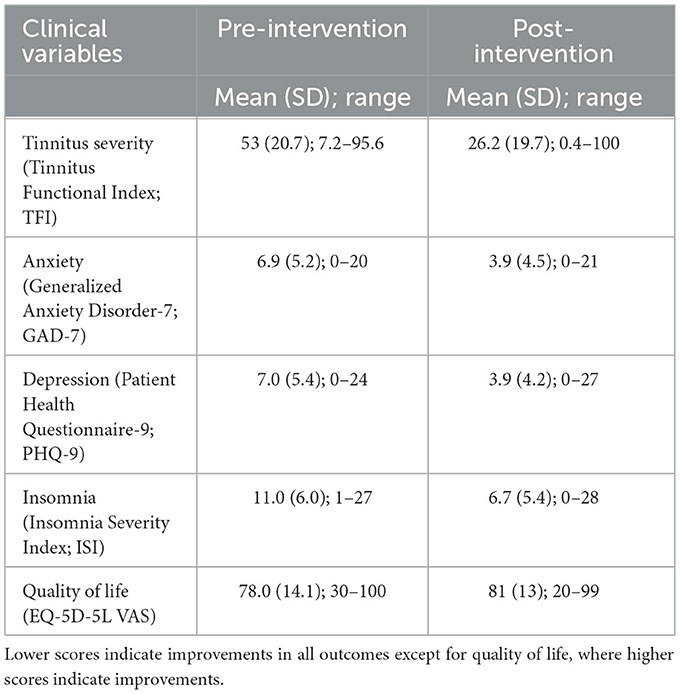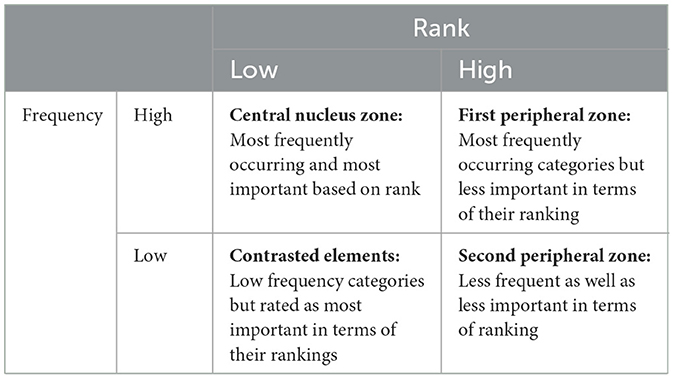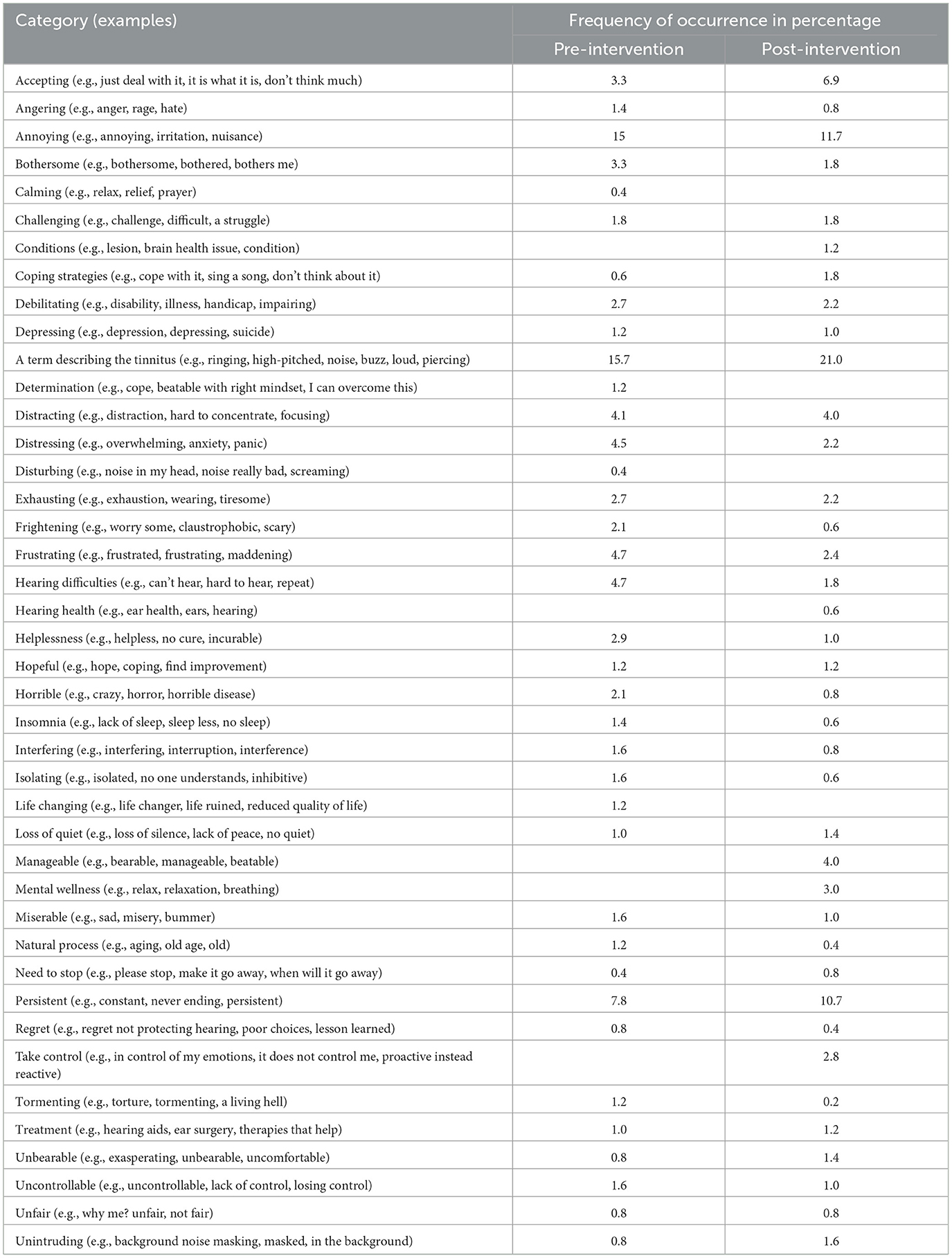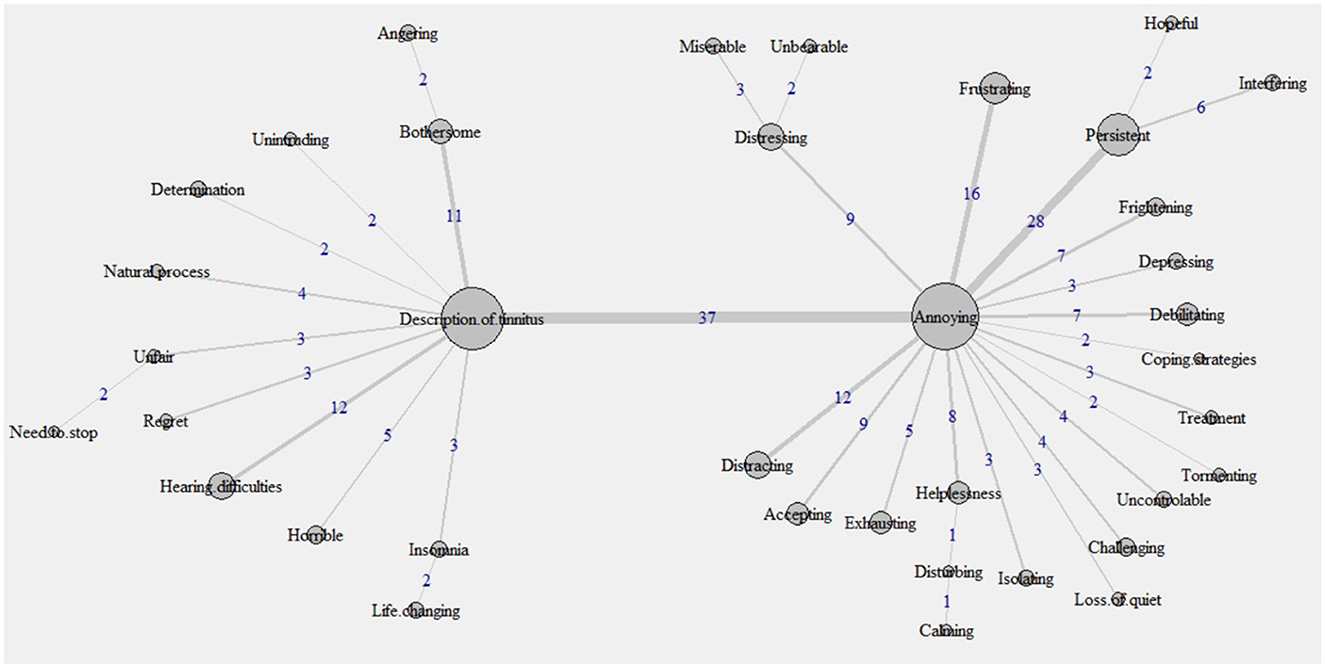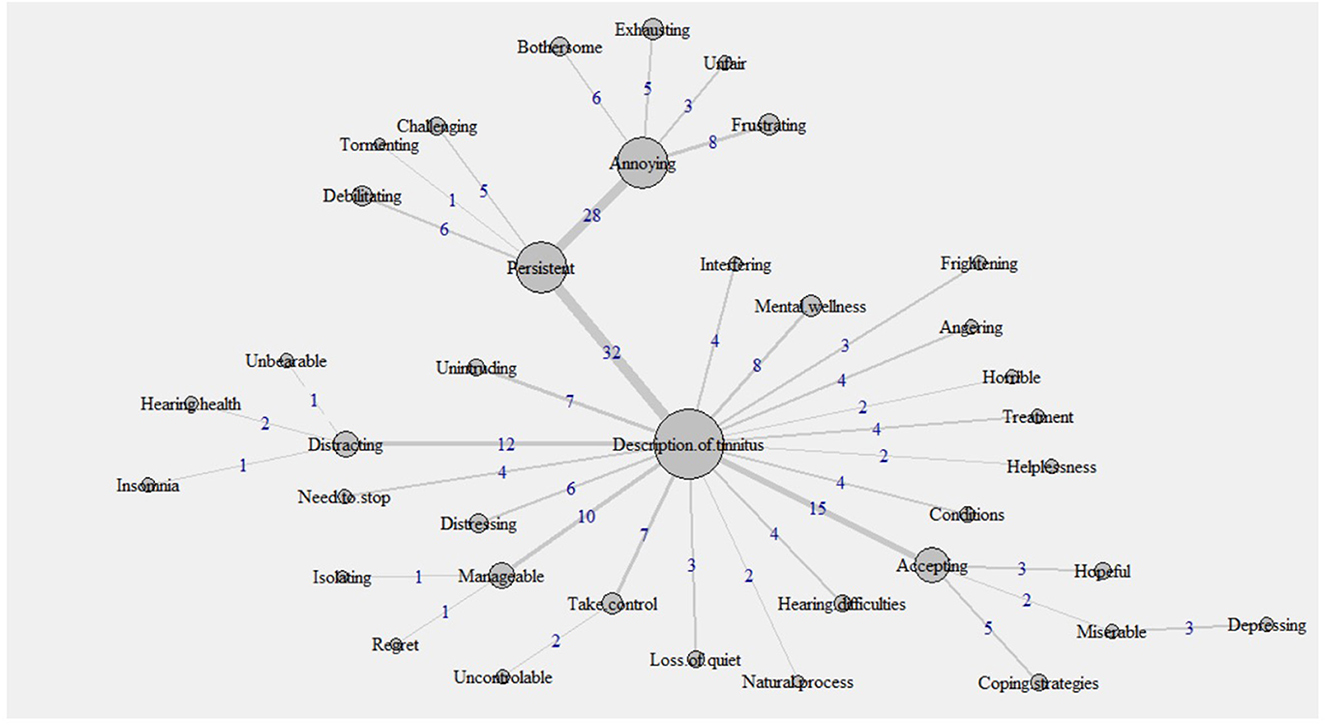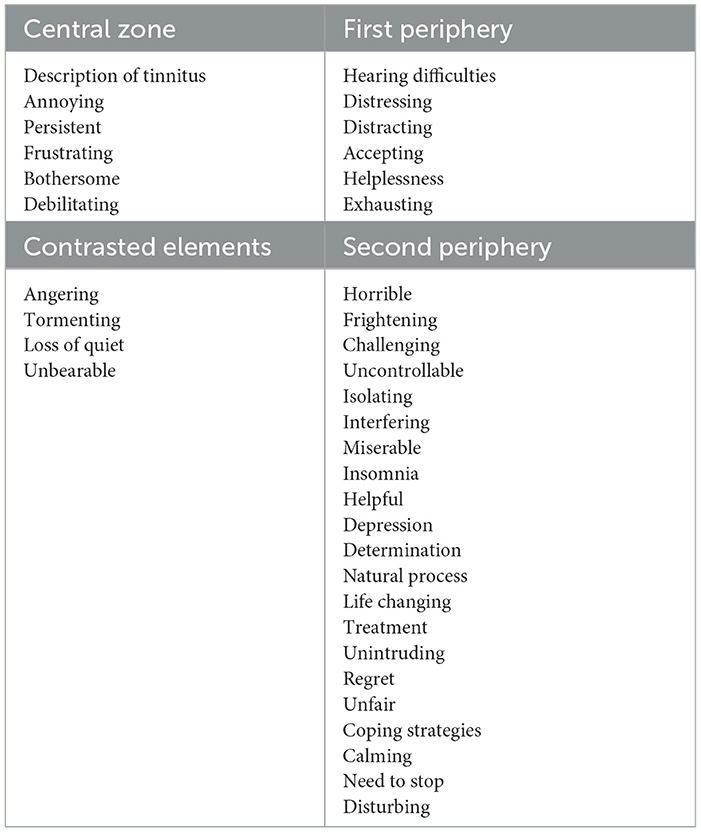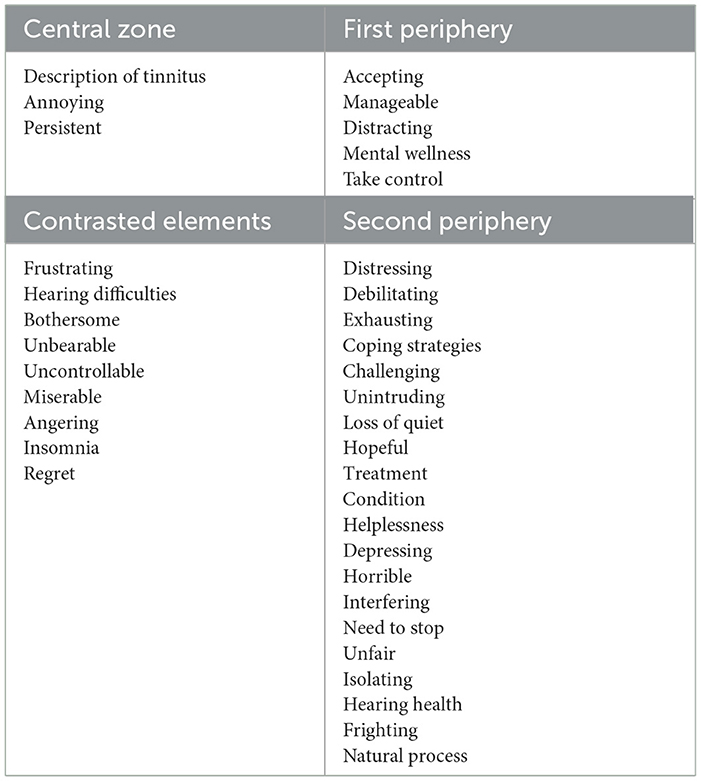- 1Department of Otolaryngology–Head and Neck Surgery, University of Colorado School of Medicine, Aurora, CO, United States
- 2UCHealth Hearing and Balance, University of Colorado Hospital, Aurora, CO, United States
- 3Virtual Hearing Lab, Collaborative Initiative Between University of Colorado School of Medicine and University of Pretoria, Aurora, CO, United States
- 4Department of Speech-Language Pathology and Audiology, University of Pretoria, Gauteng, South Africa
- 5Department of Speech and Hearing, School of Allied Health Sciences, Manipal, Karnataka, India
- 6Vision and Hearing Sciences Research Group, School of Psychology and Sport Science, Anglia Ruskin University, Cambridge, United Kingdom
- 7Laboratoire d'Études et de Recherches Appliquées en Sciences Sociales, University of Toulouse, Toulouse, France
- 8Department of Behavioral Sciences and Learning, Linköping University, Linköping, Sweden
- 9Department of Clinical Neuroscience, Division of Psychiatry, Karolinska Institute, Stockholm, Sweden
Introduction: The aim of the current study was to examine changes in social representations of tinnitus as a result of Internet-based cognitive behavioral therapy (ICBT).
Methods: The study used a pretest-posttest design. A total of 106 individuals with tinnitus (mean age 57.5 years) completed a series of questionnaires before and after undertaking ICBT. A free association task was used to collect data. The data were analyzed using qualitative content analysis and also series of quantitative analyses using the IraMuTeQ software.
Results: The most common categories reported by individuals with tinnitus before and after ICBT intervention varied. Examination of valance showed that the negative associations decreased from 81 to 56% and the positive and neutral connotations were increased after the intervention. Examination of the frequency of responses and similarities analysis did not reveal major changes following the intervention. However, the prototypical analysis, which considers both the frequency of categories as well as their ranking, showed that more positive and less negative categories appeared in the central zone and in the first periphery following the ICBT intervention.
Discussion: The study suggests that ICBT reduces the negativity associated with tinnitus and increases positivity. The results are consistent with what is seen in patient-reported outcome measures in clinical trials.
1 Introduction
Tinnitus is a frequently occurring condition in adults with prevalence of 10–15% in the general population (e.g., Shargorodsky et al., 2010; McCormack et al., 2016). There is however no known cure for tinnitus. While there is a large variety of interventions available (Langguth, 2015), Cognitive Behavioral Therapy (CBT) has the most consistent research evidence for the management of tinnitus (for review, see Fuller et al., 2020). Due to a lack of trained professionals to deliver the CBT, it was converted to an internet-based self-help format requiring minimal input from trained professionals (Andersson et al., 2002). Since the first study in Sweden, several controlled studies have been performed across the globe and the efficacy and effectiveness of ICBT for tinnitus management has been established (for review, see Beukes et al., 2019).
The outcome of interventions in clinical trials are generally measures using standardized patient-reported outcome measures (PROMs). For example, measures of tinnitus distress such as the Tinnitus Functional Index (TFI; Meikle et al., 2012) or the Tinnitus Handicap Inventory (THI; Newman et al., 1996) are often used as the primary outcome measures. The key benefit of using PROMs is that they are standardized so that the results between individuals as well as between time-points can be easily compared. However, one of the key limitations of this approach is that not all items in the structured and standardized measures are applicable to all individuals. Some individuals may not have the problems addressed in some questions but are still forced to answer these questions. Moreover, what individual patients think is most important when it comes to their treatment outcomes varies (Rademaker et al., 2021). Another way of measuring the outcomes of an intervention is to use open-ended questions which may elicit more relevant responses. However, the main challenge in this approach is to analyze the open text data and compare them. In the past, such data were generally analyzed using qualitative analysis techniques such as content analysis or thematic analysis. In a recent study, we used an automated linguistic analysis approach to analyze the response to open-ended questions and compared that with the PROMs (Manchaiah et al., 2022). The study results suggested that open-ended questions provide some additional information that was not captured in the PROMs and could complement standard PROMs. Such an approach may serve as a new way to measure outcomes in clinical trials.
The use of open-ended questions is not tied to any specific theoretical framework. Each question is posed in such a way that no prompt is given. For example, “Make a list of difficulties, which you have as a result of your tinnitus. Write down as many as you can think of.” Moreover, some respondents may provide responses that are more socially desirable which may not reflect their attitudes or behaviors (Edwards, 1957). In recent years, the use of Social Representations Theory (SRT) has become increasingly popular in research on health and disability (Manchaiah et al., 2019). Several recent studies have applied SRT in audiology to examine representations in the general population as well as people with hearing loss about hearing loss and hearing aids (Manchaiah et al., 2015a,b,c, 2023; Chundu et al., 2020, 2021). Moreover, in our recent study, we applied this approach to examine the social representations of “tinnitus” and “health” among individuals with tinnitus (n = 399) who were seeking online psychological interventions for bothersome tinnitus (Manchaiah et al., 2023). The most commonly occurring categories for tinnitus included: descriptions of tinnitus (18%), annoying (13.5%), persistent (8%), distracting (5%), and distressing (4%). The most commonly occurring categories for health included: content (12%), conditions (8%), active (7%), take control (6%), overweight (5%), and distressing (4%). Moreover, the responses to tinnitus had predominantly negative connotations (i.e., 76.9%) whereas a high percentage of responses toward their health was related to positive connotations (i.e., 46.4%). In this study, we used a free association task in which participants were prompted to think about tinnitus and come up with four to five words or phrases that came to their mind spontaneously. They were also asked to consider each word and rate each expression with positive, negative, or neutral valance (or connotation). Considering the spontaneous nature of this task, it is assumed that the method helps examine the semantic universe of participants and minimizes social desirability bias (Hovardas and Korfiatis, 2006). This approach could potentially solve the problem of just using open-ended questions without a theoretical perspective as well as help overcome social desirability bias to some degree.
Social representations are generally referred to as a “social psychological approach articulating individual thinking and feeling with collective interaction and communication” (Wagner, 2020). Unlike attitude theories, SRT helps understand the collective attitude considering their social environment and norms (Bidjari, 2011). According to Moscovici (1988), social representations are: (i) “a system of values, ideas, metaphors, beliefs, and practices” that helps to create a “social order” and allows the members of the society to have a better understanding of the community they live in, and (ii) allows for the exchange of information and ideas among the members of the community regarding a particular object. It is believed that social representations are hard to change. Without a strong intervention, it may take several decades to notice change in social representations. However, the strong influence of media and/or intervention can change the social representation of an object in a specific group (Jodelet, 2012). However, we are not aware of any studies that have examined the change in social representations about health or disability following an intervention. If proven effective, this approach could add to the medical research methodology, especially for the way in which we measure outcomes in clinical trials.
We have reported social representations of tinnitus before ICBT in our recent publications (Beukes et al., 2022b; Manchaiah et al., 2023). The aim of the current study was to examine changes in social representation of tinnitus among individuals with tinnitus following undertaking ICBT.
2 Methods
2.1 Study design
The study used a pretest-posttest design nested in three separate clinical trials of ICBT for tinnitus (Beukes et al., 2021a,b, 2022a). Ethical approval (IRB-FY17-209 and IRB-FY20-200-1) was obtained from the Institutional Review Board at Lamar University, Beaumont, Texas, United States.
2.2 Data collection
All the data were collected online using the ePlatform using a series of structured as well as open-ended questionnaires before and after the intervention. The structured outcome measures included the TFI (Meikle et al., 2012) as a measure of tinnitus distress, Generalized Anxiety Disorder−7 (GAD7; Spitzer et al., 2006) as a measure of anxiety, Patient Health Questionnaire-9 (PHQ9; Kroenke et al., 2001) as a measure of depression, Insomnia Severity Index (ISI) as a measure of insomnia, and the EQ-5D-5L Visual Analog Scale (VAS) as a measure of health-related quality of life. The social representation data were gathered using the free association task as used in several previous studies (Manchaiah et al., 2015a,b, 2017a,b, 2019, 2023; Germundsson et al., 2018; Chundu et al., 2020, 2021). This was done in two stages. First, participants were asked to think of five words or phrases that came to their mind spontaneously when they thought about tinnitus and to type them in the order of importance (i.e., the most important word/phrase first). In the second stage, participants were asked to consider each of the words or phrases and determine if they had a positive, neutral, or negative valance (or connotation).
2.3 Participants
Of the 311 participants who received ICBT, 106 participants (34.1% with mean age 57.5 years) provided both pre- and post-data in the current study. The participants were recruited using a variety of recruitment methods including advertising through a television broadcast, promoting the study via tinnitus support groups in Texas and the American Tinnitus Association, and contracting the company TrialFacts (Beukes et al., 2021b, 2022a). Tables 1, 2 provide the demographic as well as the clinical variables for the study participants. The mean age and duration of tinnitus was 57.7 and 13.3 years, respectively. Of the participants, 60% were female and 65% of had obtained a university degree. The mean tinnitus severity measured using the Tinnitus Functional Index (TFI) was 53/100 before undertaking the intervention and 26.2 after completing the 8-week ICBT intervention. Changes were noted in terms of anxiety, depression, insomnia, and quality of life post-intervention, as seen in Table 2.
2.4 Data analysis
The data were analyzed using a series of qualitative (content analysis) and quantitative (i.e., Chi square analysis, similarities analysis, and prototypical analysis) analyses which have been commonly used in previous social representation studies in the area of health and disability (Manchaiah et al., 2015a,b, 2017a,b, 2019, 2023; Germundsson et al., 2018; Chundu et al., 2020, 2021). The quantitative analyses were conducted using the text analysis software IraMuTeQ. Generally, multiple analyses methods are used in social representation studies to have multidimensional understanding of the data (Manchaiah et al., 2019).
2.4.1 Content analysis
The qualitative content analysis as described by Graneheim and Lundman (2004) was used to analyze the response to the free association task. This involved the grouping of similar words (e.g., annoying, irritation, and nuisance) into a category (e.g., annoying).
2.4.2 Chi square analysis
The frequency of positive, neutral, and negative valance for the words/phrases were counted and the associations between valance and pre-post responses were analyzed using the 3 × 2 Chi square analysis (3 × 2).
2.4.3 Similarities analysis
This analysis is also referred to as co-occurrence analysis that involves examining the most frequent categories as well as their interrelations to each other. The analysis was conducted using the IraMuTeQ software and is based on the mathematical graph theory (Flament, 1965). The software output results in a two-dimensional nodes and connections to each other nodes. The nodes in the graph represent the categories. The size of the nodes represents its frequency of occurrence (i.e., the larger the node, the higher frequency of the category). The lines in between the nodes show the interconnections (links) between the categories. The thickness of the lines represents the strength of the connection. This analysis considers the categories and their associations but fails to consider the ranking of each word/phrase listed.
2.4.4 Prototypical analysis
Unlike the similarities analysis, the prototypical analysis considers both the frequency as well as the ranking (i.e., the importance of ratings) of words/phrases for the free association task. This analysis helps understand both the content as well as the structure of social representations and is considered as the most important among all the analyses discussed above. The output of the prototypical analysis are presented in a 2 × 2 matrix as indicated in Table 3 (Abric, 1994). The four zones include the central zone, first peripheral zone, second peripheral zone, and contrasted elements, in their order of importance. In other words, the categories in the central zone are considered as the core social representations and are very stable (Abric, 2003). They are created from the shared practices and memories of a particular community. On the other hand, the peripheral elements are considered less stable as they vary across people and environments. The contrasted elements highlight a sub-group of the population that has a different priority to the general (majority) population (Abric, 2003).
3 Results
3.1 Content analysis
The key categories that emerged from the content analysis of the responses to the free association task about tinnitus before and after ICBT are provided in Table 4. The most common categories pre-intervention were: description of tinnitus (15.7%), annoying (15%), persistent (7.8%), frustrating (4.7%), hearing difficulties (4.7%), distressing (4.5%), and distracting (4.1%). The most frequently occurring categories following ICBT were: description of tinnitus (21%), annoying (11.7%), persistent (10.7%), accepting (6.9%), manageable (4%), and distracting (4%). Several categories that were present in pre-intervention responses were absent in post-intervention responses (i.e., calming, determination, disturbing, and life). Also, several new categories emerged during post-intervention (i.e., changing condition, hearing health, manageable, mental wellness, and take control).
3.2 Connotations associated with free association responses
Figure 1 shows the positive, neutral, and negative valance of the free association task responses about tinnitus before or after ICBT. The negative associations decreased from 81 to 56% after the intervention. Also, the positive and neutral connotations were increased from 8 and 11% to 22 and 22%, respectively, after the intervention. The Chi square analysis showed a significant association (Chi square value = 77.3; p < 0.00001) between connotations and the timing of responses (i.e., pre- vs. post-intervention).
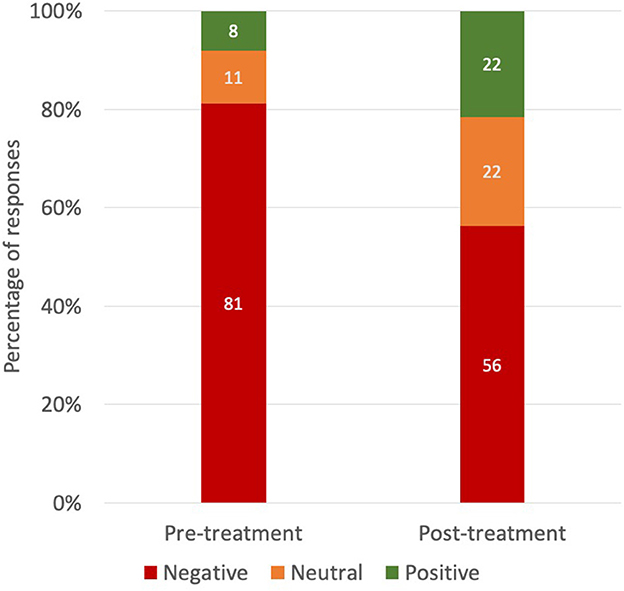
Figure 1. Percentages of associations ranked positive, neutral, and negative for responses to the free association task about tinnitus pre- and post-intervention.
3.3 Similarities analysis
The results of the similarities analysis of the responses to social representations before and after the intervention are presented in Figures 2, 3, respectively. Both the pre- and post-intervention similarities have three common dominant nodes which include the categories description of tinnitus, annoying, and persistent. However, the post-intervention similarities analysis has a new node representing the category accepting which is linked to categories such as hoping and coping strategies.
3.4 Prototypical analysis
In earlier sections, we discussed the content analysis in terms of key categories as well as their frequency. The similarities analysis considers both the frequency of categories as well as their interconnectedness. However, the prototypical analysis presented in these sections considers both the frequency as well as the ranking. Tables 5, 6 present the results of the prototypical analysis before and after the intervention, respectively. The central zone of both the pre- and post-intervention includes the categories description of tinnitus, annoying, and persistent. The categories frustrating, bothersome, and debilitating that were present pre-intervention were absent post-intervention. The pre-intervention categories in the first periphery were generally negative (i.e., hearing difficulties, distressing, distracting, helplessness, and exhausting). However, more positive categories (i.e., manageable, distracting, mental wellness, and take control) emerged in the first periphery of post-intervention. Some changes were also noted in the second periphery and contrasted elements post-intervention when compared to the pre-intervention results.
4 Discussion
The current study examined the change in social representations of tinnitus following ICBT. This study used a new theoretical perspective as well as a methodology to examine the outcomes of ICBT. The data were analyzed using various approaches used in SRT and the key findings in relation to broader tinnitus literature are discussed below.
Examining the categories and frequencies (see Table 4) highlights some commonalities and differences in responses during pre- and post-intervention. The description of tinnitus increased post-intervention from 15.7 to 21%. This could be related to the focus of the intervention regarding accepting the tinnitus and being able to focus on it and listen to the sound (Beukes et al., 2020). Tinnitus was less commonly annoying post-intervention (15% before and 11.7% after); however, it was described as persistent more frequently (7.8% before and 10.7% after). This may again reflect participants indicating acceptance despite the nature of the tinnitus. It was encouraging that the most frequently occurring categories pre-intervention, frustrating (4.7%), hearing difficulties (4.7%), distressing (4.5%), and distracting (4.1%), were reported less frequently at post-intervention. Also, the categories accepting (6.9%), manageable (4%), and distracting (4%) were the most frequently reported at post-intervention. This reflects the effective nature of the intervention in achieving its goal in helping people accept and better manage their tinnitus (Beukes et al., 2021c). Moreover, the examination of similarities highlighted three common nodes (i.e., description of tinnitus, annoying, and persistent) during both pre- and post-intervention whereas the node accepting appeared in the post-intervention similarities analysis. These two analyses did not reveal any major changes in the kind of things that come to mind when people think about their tinnitus and are consistent with main problems reported by individuals with tinnitus (Beukes et al., 2018a; Manchaiah et al., 2018; Watts et al., 2018).
Clinical studies as well as the examination of posts of individuals with tinnitus online have shown that they have negative emotions (Handscomb et al., 2017; Kimball et al., 2019). On the contrary, some studies have also revealed that some individuals with tinnitus report positive experiences (Manchaiah et al., 2015b; Beukes et al., 2018b). As there is no cure for tinnitus, the key question when planning rehabilitation is how to reduce negativity and increase positivity with acceptance and coping strategies to live well with tinnitus. Examination of the valences associated with the free association task in the current study suggested that negative associations decreased from 81 to 56% and positive and neutral connotations increased after the intervention. Moreover, the prototypical analysis that considers both the frequency of categories as well as their ranking showed that negative categories (i.e., frustrating, bothersome, and debilitating) were not part of the central zone and more positive categories were added to the first periphery (i.e., manageable, distracting, mental wellness, and take control) following the intervention. This phenomenon of reducing negative thinking and strengthening positive thinking is an important component of effective rehabilitation (Handscomb et al., 2017), echoing the results of clinical trials (Beukes et al., 2021a,b, 2022a). Overall, the current study demonstrates that ICBT may not change the type of things that come to mind but rather influence the way in which individuals think about these aspects (i.e., a more positive attitude toward them).
The study provides a new theoretical and methodological framework for examining treatment outcomes. However, it is noteworthy that the results can only be analyzed on a group level and not at the individual level (Bidjari, 2011). The change in social representations does not mean any change in biological status of the individual. Rather the change is likely to have occurred in terms how the group collectively thinks and feels about their condition influencing their values and norms. This is precisely what psychological approaches such as ICBT intend to achieve by changing the thought patterns and eventually behavior. In this context, the current study—which used the free association task that elicits free-flowing thoughts—is likely to give clearer understanding of the changes in thought patterns as a result of intervention (Hovardas and Korfiatis, 2006). Overall, the study as well as another recent study (Manchaiah et al., 2022) suggest that open-ended questions can supplement PROMs when measuring the outcomes of clinical trials, offering methodological triangulation.
4.1 Study limitations and future directions
The study is to our knowledge the first to apply SRT and the free association task to examine the outcomes of a health intervention. ICBT is not a preferred management option for all individuals with tinnitus. As a result, only those who are looking for psychological interventions were included, resulting in sampling bias. In addition, only one third of the study participants who started the clinical trial completed the outcome measures and provided the data for the free association task. Therefore, the results should be viewed as preliminary. The study examined changes in social representations as a result of an 8-week intense intervention on a small population. Future studies should aim to examine the effect of brief public health interventions on social representations in large populations. Moreover, SRT is not without controversies (Voelklein and Howarth, 2005) and is likely to supplement the existing disabilities theories rather than replacing them (Manchaiah et al., 2019).
Data availability statement
The datasets presented in this study can be found in online repositories. The names of the repository/repositories and accession number(s) can be found below: http://doi.org/10.6084/m9.figshare.15062733.
Ethics statement
The studies involving humans were approved by Institutional Review Board at Lamar University, Beaumont, Texas, United States. The studies were conducted in accordance with the local legislation and institutional requirements. The participants provided their written informed consent to participate in this study.
Author contributions
VM: Conceptualization, Data curation, Formal analysis, Funding acquisition, Methodology, Writing—original draft. SC: Formal analysis, Methodology, Visualization, Writing—review & editing. PR: Conceptualization, Data curation, Formal analysis, Methodology, Visualization, Writing—review & editing. GA: Conceptualization, Methodology, Writing—review & editing. EB: Conceptualization, Data curation, Methodology, Writing—review & editing.
Funding
The author(s) declare financial support was received for the research, authorship, and/or publication of this article. This work is partly funded by the National Institute on Deafness and Other Communication Disorders (NIDCD) of the National Institutes of Health (NIH) under the award number R21DC017214 for VM.
Conflict of interest
The authors declare that the research was conducted in the absence of any commercial or financial relationships that could be construed as a potential conflict of interest.
The author(s) declared that they were an editorial board member of Frontiers, at the time of submission. This had no impact on the peer review process and the final decision.
Publisher's note
All claims expressed in this article are solely those of the authors and do not necessarily represent those of their affiliated organizations, or those of the publisher, the editors and the reviewers. Any product that may be evaluated in this article, or claim that may be made by its manufacturer, is not guaranteed or endorsed by the publisher.
References
Abric, J.-C. (2003). “La recherche du noyau central et la zone muette des representations sociales,” in Méthodes d'études des representations sociales, ed J. C. Abric (Ramonville Saint-Agne: Érès), 60–80.
Andersson, G., Strömgren, T., Ström, L., and Lyttkens, L. (2002). Randomized controlled trial of internet-based cognitive behavior therapy for distress associated with tinnitus. Psychosom. Med. 64, 810–816. doi: 10.1097/00006842-200209000-00014
Beukes, E., Andersson, G., Manchaiah, V., and Kaldo, V. (2021c). Cognitive Behavioral Therapy for Tinnitus. San Diego, CA: Plural Publishing Inc.
Beukes, E. W., Andersson, G., Fagelson, M., and Manchaiah, V. (2021a). Audiologist-supported internet-based cognitive behavioral therapy for Tinnitus in the United States: a pilot trial. Am. J. Audiol. 30, 717–729. doi: 10.1044/2021_AJA-20-00222
Beukes, E. W., Andersson, G., Fagelson, M., and Manchaiah, V. (2022a). Internet-based audiologist-guided cognitive behavioral therapy for tinnitus: randomized controlled trial. J. Med. Intern. Res. 24, e27584. doi: 10.2196/27584
Beukes, E. W., Andersson, G., Fagelson, M. A., and Manchaiah, V. (2021b). Dismantling internet-based cognitive behavioral therapy for tinnitus. The contribution of applied relaxation: A randomized controlled trial. Int. Intervent. 25, 100402. doi: 10.1016/j.invent.2021.100402
Beukes, E. W., Chundu, S., Ratinaud, P., Andersson, G., and Manchaiah, V. (2022b). Experiential characteristics among individuals with tinnitus seeking online psychological interventions: a cluster analysis. Brain Sci. 12, 1221. doi: 10.3390/brainsci12091221
Beukes, E. W., Fagelson, M. A., Aronson, E. P., Munoz, M. F., Andersson, G., and Manchaiah, V. (2020). Readability following cultural and linguistic adaptations of an Internet-based Intervention for Tinnitus for use in the United States. Am. J. Audiol. 29, 97–109. doi: 10.1044/2019_AJA-19-00014
Beukes, E. W., Manchaiah, V., Allen, P. M., Baguley, D. M., and Andersson, G. (2019). Internet-based interventions for adults with hearing loss, tinnitus, and vestibular disorders: a systematic review and meta-analysis. Trends Hear. 23, 2331216519851749. doi: 10.1177/2331216519851749
Beukes, E. W., Manchaiah, V., Andersson, G., Allen, P. M., Terlizzi, P. M., and Baguley, D. M. (2018a). Situationally influenced tinnitus coping strategies: a mixed methods approach. Disabil. Rehabil. 40, 2884–2894. doi: 10.1080/09638288.2017.1362708
Beukes, E. W., Manchaiah, V., Valien, T. E., Baguley, D. M., Allen, P. M., and Andersson, G. (2018b). Positive experiences related to living with tinnitus: a cross-sectional survey. Clin. Otolaryngol. 43, 489–495. doi: 10.1111/coa.13002
Bidjari, A. F. (2011). Attitude and social representation. Proc. Soc. Behav. Sci. 30, 1593–1597. doi: 10.1016/j.sbspro.2011.10.309
Chundu, S., Allen, P. M., Han, W., Ratinaud, P., Krishna, R., and Manchaiah, V. (2021). Social representation of hearing aids among people with hearing loss: an exploratory study. Int. J. Audiol. 60, 964–978. doi: 10.1080/14992027.2021.1886349
Chundu, S., Manchaiah, V., Han, W., Thammaiah, S., Ratinaud, P., and Allen, P. M. (2020). Social representation of ‘hearing loss' among people with hearing loss: an exploratory cross-cultural study. J. Am. Acad. Audiol. 31, 725–739. doi: 10.1055/s-0040-1719127
Edwards, A. L. (1957). The social desirability variable in personality assessment and research. Acad. Med. 33, 610–611.
Fuller, T., Cima, R., Langguth, B., Mazurek, B., Vlaeyen, J. W., and Hoare, D. J. (2020). Cognitive behavioural therapy for tinnitus. Cochr. Database Syst. Rev. 1, CD012614. doi: 10.1002/14651858.CD012614.pub2
Germundsson, P., Manchaiah, V., Ratinaud, P., Tympas, A., and Danermark, B. (2018). Patterns in the social representation of “hearing loss” across countries: how do demographic factors influence this representation?. Int. J. Audiol. 57, 925–932. doi: 10.1080/14992027.2018.1516894
Graneheim, U. H., and Lundman, B. (2004). Qualitative content analysis in nursing research: concepts, procedures and measures to achieve trustworthiness. Nurse Educ. Today 24, 105–112. doi: 10.1016/j.nedt.2003.10.001
Handscomb, L. E., Hall, D. A., Shorter, G. W., and Hoare, D. J. (2017). Positive and negative thinking in tinnitus: factor structure of the tinnitus cognitions questionnaire. Ear Hear. 38, 126–132. doi: 10.1097/AUD.0000000000000365
Hovardas, T., and Korfiatis, K. J. (2006). Word associations as a tool for assessing conceptual change in science education. Learn. Instruct. 16, 416–432. doi: 10.1016/j.learninstruc.2006.09.003
Jodelet, D. (2012). “Interconnections between social representations and intervention,” in Social representations in the ‘social arena', ed A. De Rosa (London: Routledge), 77–88.
Kimball, S. H., Hamilton, T., Benear, E., and Baldwin, J. (2019). Determining emotional tone and verbal behavior in patients with tinnitus and hyperacusis: an exploratory mixed-methods study. Am. J. Audiol. 28, 660–672. doi: 10.1044/2019_AJA-18-0136
Kroenke, K., Spitzer, R. L., and Williams, J. B. (2001). The PHQ-9: validity of a brief depression severity measure. J. Gen. Intern. Med. 16, 606–613. doi: 10.1046/j.1525-1497.2001.016009606.x
Langguth, B. (2015). Treatment of tinnitus. Curr. Opin. Otolaryngol. Head Neck Surg. 23, 361–368. doi: 10.1097/MOO.0000000000000185
Manchaiah, V., Andersson, G., Fagelson, M. A., Boyd, R. L., and Beukes, E. W. (2022). Use of open-ended questionnaires to examine the effects of tinnitus and its relation to patient-reported outcome measures. Int. J. Audiol. 61, 592–599. doi: 10.1080/14992027.2021.1995790
Manchaiah, V., Baguley, D. M., Pyykkö, I., Kentala, E., and Levo, H. (2015c). Positive experiences associated with acquired hearing loss, Ménière's disease, and tinnitus: a review. Int. J. Audiol. 54, 1–10. doi: 10.3109/14992027.2014.953217
Manchaiah, V., Beukes, E. W., Granberg, S., Durisala, N., Baguley, D. M., Allen, P. M., et al. (2018). Problems and life effects experienced by tinnitus research study volunteers: an exploratory study using the ICF classification. J. Am. Acad. Audiol. 29, 936–947. doi: 10.3766/jaaa.17094
Manchaiah, V., Chundu, C., Ratinaud, R., Anderson, G., and Beukes, E. W. (2023). Social representations of ‘tinnitus' and ‘health' among individuals with tinnitus seeking online psychological interventions. Audiol. Res. 13, 207–220. doi: 10.3390/audiolres13020020
Manchaiah, V., Danermark, B., Ahmadi, T., Tom,é, D., Rajalakshmi, K., Zhao, F., et al. (2015a). Social representation of ‘hearing loss': cross-cultural exploratory study in India, Iran, Portugal and United Kingdom. Clin. Interv. Aging 10, 1857–1872. doi: 10.2147/CIA.S91076
Manchaiah, V., Danermark, B., Ratinaud, P., and Germundsson, P. (2019). Disability and Social Representation Theory: The Case of Hearing Loss. Oxon: Routledge.
Manchaiah, V., Danermark, B., Vinay Ahmadi, T., Tomé, D., Rajalakshmi, K., et al. (2015b). Social representation of ‘hearing aids': cross-cultural study in India, Iran, Portugal and United Kingdom. Clin. Interv. Aging 10, 1601–1615. doi: 10.2147/CIA.S86108
Manchaiah, V., Zhao, F., Widen, S., Auzenne, J., Beukes, E. W., Ahmadi, T., et al. (2017a). Social representation of ‘music' in young adults: a cross-cultural study. Int. J. Audiol. 56, 24–32. doi: 10.1080/14992027.2016.1227481
Manchaiah, V., Zhao, F., Widen, S., Auzenne, J., Beukes, E. W., Ahmadi, T., et al. (2017b). Social representation of ‘loud music' in adolescents and young adults: a cross-cultural study. J. Am. Acad. Audiol. 28, 522–533. doi: 10.3766/jaaa.16046
McCormack, A., Edmondson-Jones, M., Somerset, S., and Hall, D. (2016). A systematic review of the reporting of tinnitus prevalence and severity. Hear. Res. 337, 70–79. doi: 10.1016/j.heares.2016.05.009
Meikle, M. B., Henry, J. A., Griest, S. E., Stewart, B. J., Abrams, H. B., McArdle, R., et al. (2012). The tinnitus functional index: development of a new clinical measure for chronic, intrusive tinnitus. Ear Hear. 33, 153–176. doi: 10.1097/AUD.0b013e31822f67c0
Moscovici, S. (1988). Notes towards a description of social representations. Eur. J. Soc. Psychol. 18, 211–250. doi: 10.1002/ejsp.2420180303
Newman, C. W., Jacobson, G. P., and Spitzer, J. B. (1996). Development of the Tinnitus handicap inventory. Arch. Otolaryngol. Head Neck Surg. 122, 143–148. doi: 10.1001/archotol.1996.01890140029007
Rademaker, M. M., Essers, B., Stokroos, R. J., Smit, A. L., and Stegeman, I. (2021). What tinnitus therapy outcome measures are important for patients? A discrete choice experiment. Front. Neurol. 12, 668880. doi: 10.3389/fneur.2021.668880
Shargorodsky, J., Curhan, G. C., and Farwell, W. R. (2010). Prevalence and characteristics of tinnitus among US adults. Am. J. Med. 123, 711–718. doi: 10.1016/j.amjmed.2010.02.015
Spitzer, R. L., Kroenke, K., Williams, J. B., and Löwe, B. (2006). A brief measure for assessing generalized anxiety disorder: the GAD-7. Arch. Intern. Med. 166, 1092–1097. doi: 10.1001/archinte.166.10.1092
Voelklein, C., and Howarth, C. (2005). A review of controversies about social representations theory: a british debate. Cult. Psychol. 11, 431–454. doi: 10.1177/1354067X05058586
Wagner, W. (2020). Social Representation Theory: An Historical Outline. Oxford Research Encyclopedia of Psychology. Available from: https://oxfordre.com/psychology/view/10.1093/acrefore/9780190236557.001.0001/acrefore-9780190236557-e-606 (accessed August 20, 2021).
Keywords: tinnitus, social representations, attitude, free association, intervention outcome
Citation: Manchaiah V, Chundu S, Ratinaud P, Andersson G and Beukes EW (2023) Internet-based cognitive behavioral therapy positively influences the social representations of tinnitus. Front. Audiol. Otol. 1:1302005. doi: 10.3389/fauot.2023.1302005
Received: 25 September 2023; Accepted: 13 November 2023;
Published: 04 December 2023.
Edited by:
Adriana L. Smit, University Medical Center Utrecht, NetherlandsReviewed by:
David Tomé, Polytechnic of Porto, PortugalGian Gaetano Ferri, University of Bologna, Italy
Copyright © 2023 Manchaiah, Chundu, Ratinaud, Andersson and Beukes. This is an open-access article distributed under the terms of the Creative Commons Attribution License (CC BY). The use, distribution or reproduction in other forums is permitted, provided the original author(s) and the copyright owner(s) are credited and that the original publication in this journal is cited, in accordance with accepted academic practice. No use, distribution or reproduction is permitted which does not comply with these terms.
*Correspondence: Vinaya Manchaiah, dmluYXlhLm1hbmNoYWlhaEBjdWFuc2NodXR6LmVkdQ==
 Vinaya Manchaiah
Vinaya Manchaiah Srikanth Chundu
Srikanth Chundu Pierre Ratinaud7
Pierre Ratinaud7 Gerhard Andersson
Gerhard Andersson Eldre W. Beukes
Eldre W. Beukes